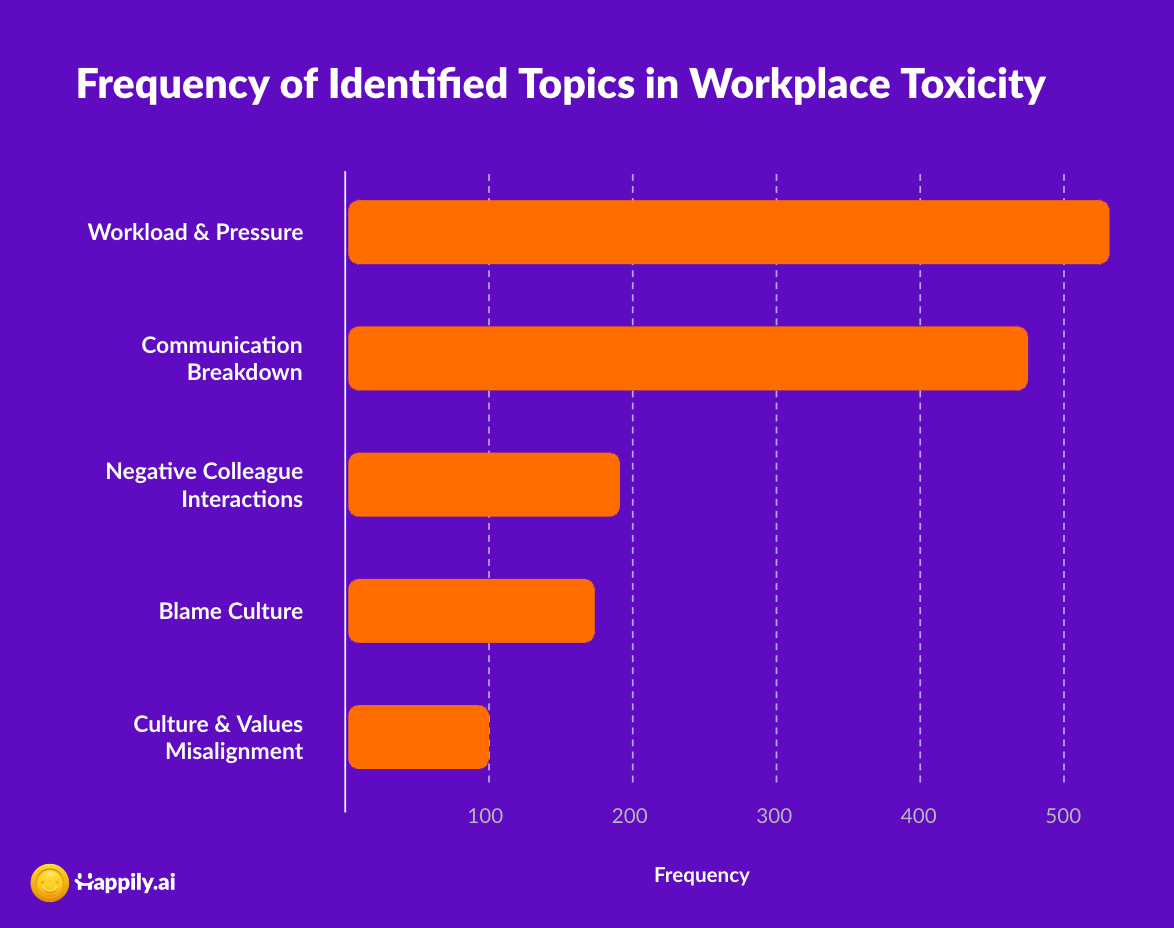Toxic workplace behaviors are now cited as the leading cause of employee turnover and dissatisfaction. Drawing from a dataset of over a thousand employee narratives, our research reveals the undercurrents of behaviors undermining the modern workplace. This article synthesizes these voices through data analytics to clarify what we must prioritize to create a healthier, more productive workplace.
Toxic behavior in the workplace is a systematic pattern of conduct that undermines the organization and harms its employees. Characterized by intentional harm, persistent negativity, and actions that degrade colleagues and the company culture, it manifests through repetitive aggression, harassment, and subtle acts of undermining or exclusion.
The true measure of toxicity is its impact: it leaves a lasting imprint on individuals, teams, and the organizational ethos, threatening the foundation of a productive and positive workplace.
What the data says
The first step in our analysis involved an algorithmic deep dive into the dataset. Dominating the landscape is the theme of 'Workload & Pressure,' signaling that high work expectations and time constraints are felt most acutely. It's a reminder that pursuing productivity and results can erode workplace well-being when left unmanaged.
'Blame Culture' also emerged as a recurrent theme. Consider a story shared by a project coordinator: "A missed deadline in our team spiraled into a blame game, sidelining problem-solving for fault-finding." This pattern of behavior reveals a critical pain point within team dynamics, where the default response to challenges is finger-pointing rather than collaborative problem-solving.

- Workload & Pressure: This was the most commonly reported factor, indicating a high level of stress and pressure felt by employees.
- Communication Breakdown: This topic, which includes issues like misunderstandings and poor communication, was the second most frequent.
- Negative Colleague Interactions: Unpleasant interactions with colleagues, potentially including harassment or undermining behaviors, were also a significant concern.
- Blame Culture: Situations where blame is assigned rather than solutions sought were noted as well.
- Cultural & Values Misalignment: The least frequent but still notable were problems related to the alignment between company values and employee experiences.
Another narrative highlights a widespread communication breakdown: "Seeking task clarification, I was met with my manager’s dismissive 'figure it out yourself,' a stance that stifles learning and growth." Another employee shared a disheartening experience of feeling invisible: "Leading a project to success without acknowledgment made me question my worth to the team." These are not isolated incidents but symptoms of cultures that routinely fail to recognize and respect individual contributions.
Navigating the negative emotions
A sentiment analysis reveals that while all toxic behaviors negatively tint the work experience, certain issues cast a longer emotional shadow. 'Cultural & Values Misalignment' emerges as the most emotionally charged topic, though it's less frequently voiced. This insight suggests that a misfit between personal and organizational values doesn't just rub employees the wrong way—it grates against their very sense of purpose and belonging.

Similarly, 'Blame Culture' leaves a deep emotional imprint. The analysis shows that blame is corrosive, eating away at trust and stifling the flow of open communication. When mistakes are treated as felonies rather than opportunities to learn, employees retreat into their shells, innovation suffers, and the collective spirit diminishes.
'Communication Breakdown' shows a surprisingly neutral and occasionally positive sentiment. This anomaly suggests that employees might see communication issues as less of a systemic failure and more as a fixable glitch. It speaks to resilience and readiness among the workforce to engage with surmountable challenges.
This quantitative emotional mapping doesn't just quantify feelings—it qualifies them. It highlights not only what employees are reacting to but how deeply they are affected. By understanding the emotional valence attached to each aspect of workplace toxicity, leaders can prioritize interventions that not only solve problems but also heal emotional rifts.
The path to eliminating toxic behaviors
The insights from our analysis have far-reaching implications for the health of organizations. A thriving work environment stems not from ad-hoc solutions but from a fundamental re-evaluation of how behaviors are modeled and reinforced at every level of leadership. Mutual respect and open communication must not be aspirational but standard practice.
Informed interventions can reshape the workplace. Anecdotal evidence from staff suggests the efficacy of these measures: "Post-conflict resolution training, our team communication has taken a turn for the better," notes a support staff member. Such targeted interventions, grounded in the specific issues highlighted by our data, can catalyze positive changes in organizational dynamics.
The role of company values
A critical but often overlooked aspect in addressing workplace toxicity is the role of core company values. These values are not merely words on a plaque; they are the guiding principles that shape behavior, decision-making, and company culture. When clearly defined and authentically practiced, they serve as an immune system against toxic behaviors.
Best practices for communicating with employees when toxic behaviors are reported hinge on these values. A transparent process aligned with the company's principles engenders trust and reinforces the message that toxic behavior is unacceptable.
Best Practices for Communication:
- Immediate Acknowledgment: When an employee reports toxic behavior, immediate acknowledgment of the report demonstrates that the company takes such issues seriously.
- Consistent Updates: Keeping the reporting employee updated on the status of their report shows a commitment to transparency and resolution.
- Confidentiality: Respecting the privacy of all parties involved is crucial. It’s a delicate balance of being open while protecting individual confidentiality.
- Value-Aligned Action: Any action taken should align with company values, reinforcing the idea that these values are not just theoretical but actionable.
Reinforcing a Shared Vision
The efficacy of combating workplace toxicity is not about identifying and resolving individual issues but rather cultivating an environment where such behaviors are inherently discouraged. It’s about instilling a shared set of values that are not only universally upheld but also actively rewarded.
To foster such a culture, an organization must ensure that its core values are not just words on a wall but are deeply embedded in every aspect of the workplace. This means integrating them into hiring practices, performance reviews, and daily operations, ensuring that every member of the team is aligned with these ideals. It is less about setting up systems to monitor and track toxic behaviors and more about creating an ethos where such behaviors are naturally deterred—a culture where everyone understands that toxic actions are antithetical to the organization's collective mission.
Creating a Culture Where Values Are Lived:
- Recognition and Reward Systems: Introduce mechanisms that recognize and reward behavior that exemplifies shared values. This could be through employee of the month awards, shout-outs in team meetings, or peer recognition platforms like Happily.ai.
- Leadership by Example: Leaders must exemplify the organization’s values. When leaders consistently demonstrate the shared values in action, it sets a standard for the rest of the team to emulate.
- Values-Based Decision-Making: Encourage decision-making at all levels that reflect the organization's values. When faced with business decisions, the options chosen should always align with these values, reinforcing their importance.
- Regular Reflection and Dialogue: Create spaces for teams to regularly reflect on how well they are living up to the shared values. Encourage open dialogue about instances where the organization may have fallen short and discuss ways to improve.
Clean cities rely not on the absence of litterers but on citizens who maintain cleanliness. They pick up litter not only because they are compelled to but because it violates the shared value of cleanliness. Similarly, in a healthy workplace, employees take initiative in upholding the values, knowing that to do otherwise would be contrary to the collective belief system of their community.
In this environment, toxic behaviors are like litter on the streets—out of place and promptly addressed not just by leadership but by anyone who notices them. This kind of proactive and collective guardianship ensures that the values are not just a framework but a living, breathing aspect of the organizational culture.
By fostering this shared sense of responsibility and stewardship, organizations can create a self-sustaining environment where the right behaviors are natural and the wrong ones are naturally rooted out. It’s a shift from enforcement to embodiment, from policy to practice, and from rules to shared beliefs. This is the essence of a non-toxic workplace.
Conclusion
Our study calls upon leaders to move beyond merely recognizing issues to actively forging solutions. The most prominent toxic behaviors reported were workload & pressure, communication breakdowns, and a blame culture. The most negative sentiments were shared in regard to cultural & values misalignment and blame culture.
To truly eliminate toxic behaviors, values must be lived daily—they must be part of the very fabric of the company. It requires leadership to exemplify these values, policies, and procedures that reflect them, and continuous reinforcement through training and communication. Only then can a company hope to transform its culture, making it not just resistant to toxicity but inherently healthy and positive.










